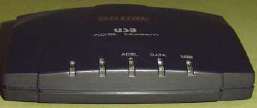eXtra Notes

|
|
 |
Graham K. Rogers |
|
|
Previous note (1) can be found here.
Previous note (2) can be found here.
Previous note (3) can be found here.
I first used this technology more than 10 years ago. Modem speeds then were 2,400bps and the new box gave me a lightning fast 9600bps. It was fine for a few months but then the company, which was part of the (now) Prime Minister's portfolio, put the annual fee up to 2,700 baht per month. When the "suit" came to my office to collec the box he told me that the government concession was only for a limited period, so they needed to make a profit in the few years they had. Up went the price as the reasoning was (1) the corporate users would absorb the fairly low cost, while (2) they would accept the loss of a few ordinary users. That business philosophy now causes me never to choose that company's products or services. On a personal level I stick to DTAC and, now, the ADSL services from TRUE, rather than LoxleyCS.
It took me a few months to get round to the ADSL idea not because of the price, but the blank looks one gets from many of the staff as soon as one mentions the word, "Mac," or "Apple". During the first application, when the company mislaid the form I mailed in, the guy they sent out to my office was helpful until I ticked the space for type of computer, Apple; and the operating system, OSX. He actually stiffened. I compounded my errors by saying I did not want the USB modem and would buy my own connector. He left the office and I dumped the form.
Over the few months I had suggestions from someone who did connect using this method. He gave me three pieces of advice: don't tell them about the Mac, take the USB modem, give it away or dump it.
The appplication went smoothly at the Central Pinklao branch of TRUE and a couple of days later, a sweet lady phoned me and I collected the USB modem the next afternoon. An hour later we were back helping a friend start the process.
Following the advice of the friend who has installed and run ADSL, I went into Phantip last week and bought a PCi BRM-04 bridge/router. Even without ADSL connected, once this is powered up, it is possible to access the setup procedures -- installed in the modem itself -- using a browser. I used Safari and typed in http://10.0.0.2 which let me in. It reminded me of typing in http://127.0.0.1:631/ to give one access to the CUPS, or common unix printing system, setup pages. An advantage (for me) of this device is that it has four ports, so I can either run four computers (not legal under the terms of the TRUE agreement) or install a small network. I will have to think about that.

|

|

|

|
When I went to collect the ADSL modem (and pay the money) the store was in its usual busy state, but I still get smiles from the staff. I always take along trusted Thai friends to ease me through the paper-work. The modem was in my hands in a short while, along with notification about the new telephone line to be installled on Friday, plus a SIM-card for Orange. They are trying.
I started with the installer CDROM. Apart from some fairly-well made graphics that run in QuickTime, the rest was all antiquated .dll and .exe files, so I had a look at the modem itself: "Billion"; "made in China". Where to start? Try Google. They may be made in China, but the company, Billion, is based in Australia and has an accessible website. On the downlaods page are drivers for OSX, OS9 and for Linux, although Linux users are surely even less likey than Mac folk to use this technology?
I downloaded the Mac drivers, which are 2MB and include both OS9 and OSX files; and I also downloaded an extensive Mac/Linux manual. I put the driver on as an experiment but (at this stage) cannot use it as it does not appear in the modem list. This is because it emulates Ethernet, so we have to pretend we are using a network.
I have a gripe about this: note that Billion have provided the drivers and documentation for the operating systems (Linux, OSX, OS9 and Windows) online; while TRUE almost denies their existence. It would not be difficult, if there were any Mac user who did want to use the USB device, for TRUE either to have a couple of CDROMs at their premises, or even to offer to mail them later. But then, for so many people, Macs do not exist.
The telephone lines can carry several signals and, if they are not at the same frequencies, will not interfere with each other (this is the analogue signal over copper wire and not the digital). In the case of the ADSL network, the telephone/voice signal is carried at a lower level, with the data signal above it. You can also do this with electrical cables as electicity runs through the wires at set frequencies. This week in the USA, the FAA authorised the cable companies (electrical not those like UBC) to provide data services to the public. Now if the Electricity Authorities here would get to grips with this system, imagine how much more valuable a public offering of their shares would be, not to mention the better choices for the data-sending public.
Two or three events have happened of late that suggest the Macs and OSX will have a little more exposure. The iPod, of course, has had a lot to do with this, and I see it is part of the "get them through the doors" philosophy. Others think of this as a "halo effect", pleasing iPods force customers to look more closely at the Macintosh range. The G5 computers (both standalone and iMac) have added to the cachet, while reliability of Macs and Windows problems (such as viruses) have not endeared that OS to its users. The men at the top there do not help either.
It was with a touch of surprise, then, that I walked into Central World last Friday (15 October) and found loads of G5 iMacs in a new area being used by the ICT Ministry. The government has (A) bought a load of G5s (plus heaven knows what else) and arranged for the current eMacs to be included on their lower cost scheme to get computers out to the masses.
They did actually try with the Linux machines earlier, and it is hardly their fault if the users (allegedly) took the Linux off and put on Phantip versions of Windows. At least it had the effect of making the Beast of Redmond take some notice of what was going on outside the continental United States. Instead of reducing prices to what would have been a sensible norm for a country with lower average incomes, they took the coward's way out and sent us (actually You, not me) a watered down version of XP, claiming that they were doing you a favour. Perhaps if this is what caused even one user to consider OSX, they were.
Rumours about Tiger, the next version of OSX, have been rampant for months, once Steve Jobs announced it at a conference. We saw some of the interface, we saw some of the utilities and technologies; but we did not know "when". Apparently, Amazon made an error by putting up a pre-order form (since removed) for Tiger and on that form was a date: 31 March 2005. Who knows?
Rumours about Macs always come and go but now people are beginning to get edgy as Apple seem to be overdue on updates to both the PowerBook and iBook ranges. One site suggested that this Tuesday (19 October) could well see some new iBooks announced. Do not hold your breath for the G5 PowerBook.
Rumours about Panther, the current iteration of OSX, which is now at version 10.3.5 suggest that an update to 10.3.6, of about 36MB, is coming pretty soon. And it is all these parge updates and other software downloads that make ADSL more of a priority these days.
All materials ©copyright G.K. Rogers. Free for individual use.
Other links:

|

|

|

|

|

|

|

|

|

|

|

|

|

|

|

|

|

|
For further information, e-mail to Graham K. Rogers.

To eXtensions, Current items
To eXtensions, Year Two
To eXtensions, Book Reviews
To Education Page